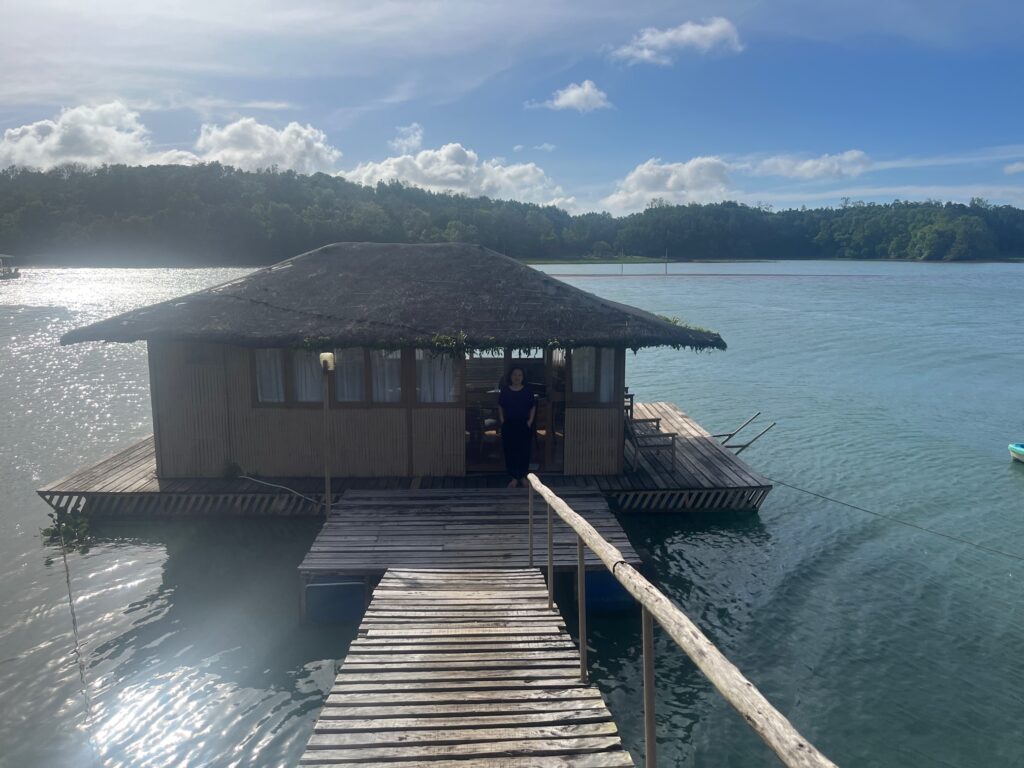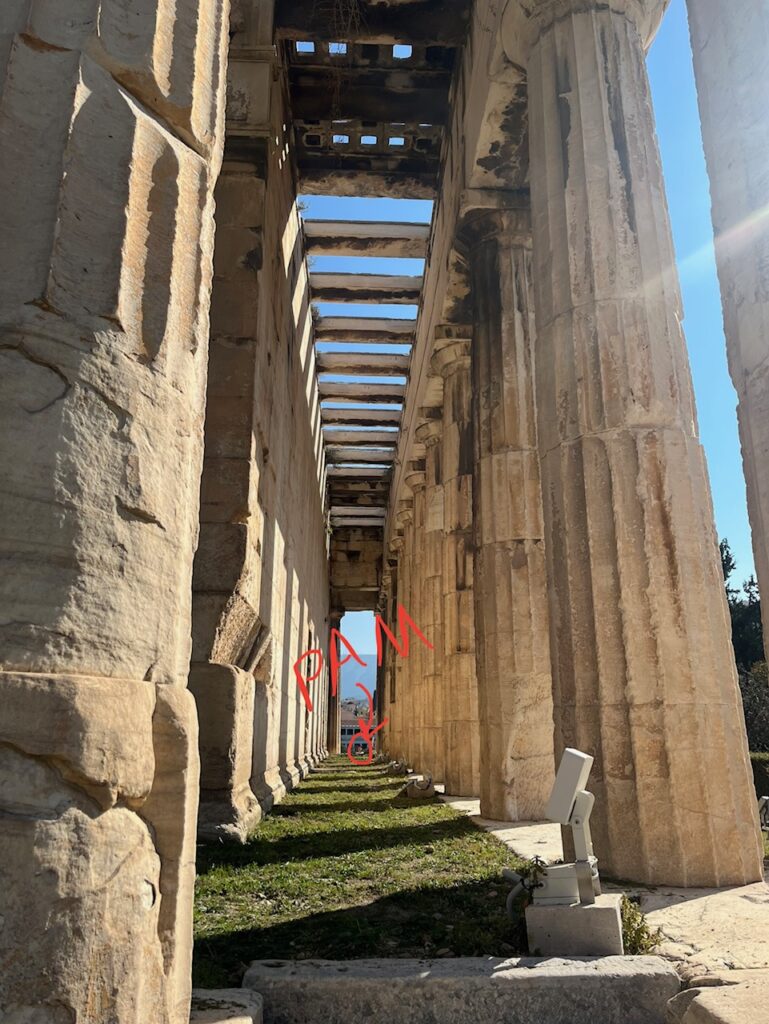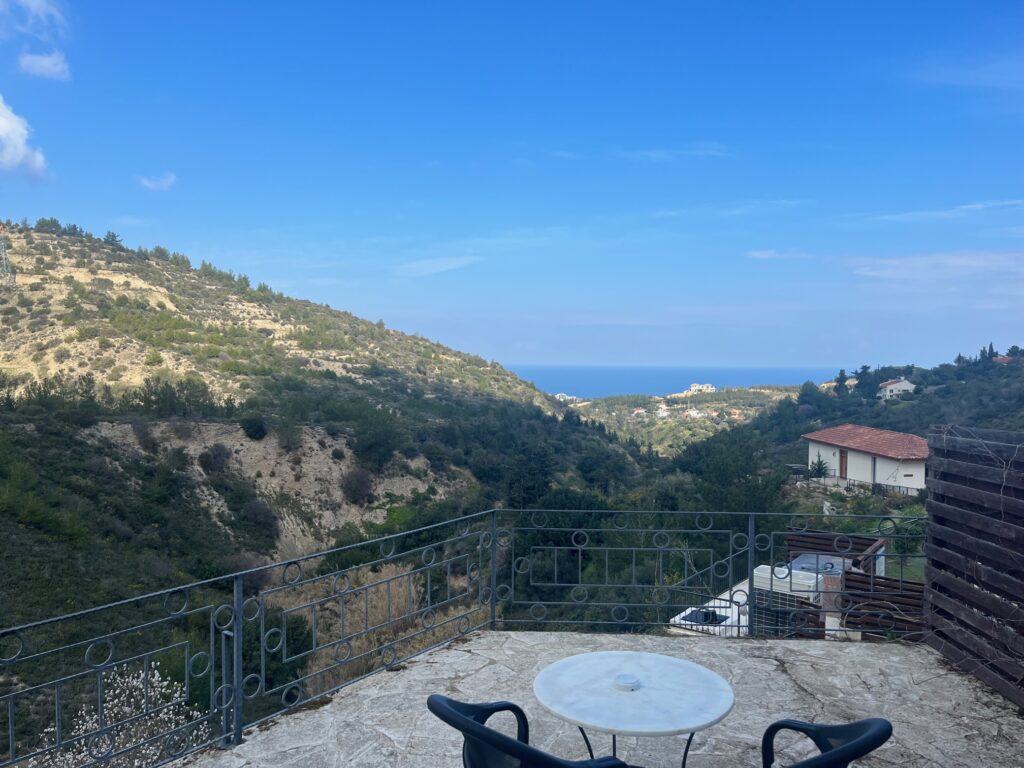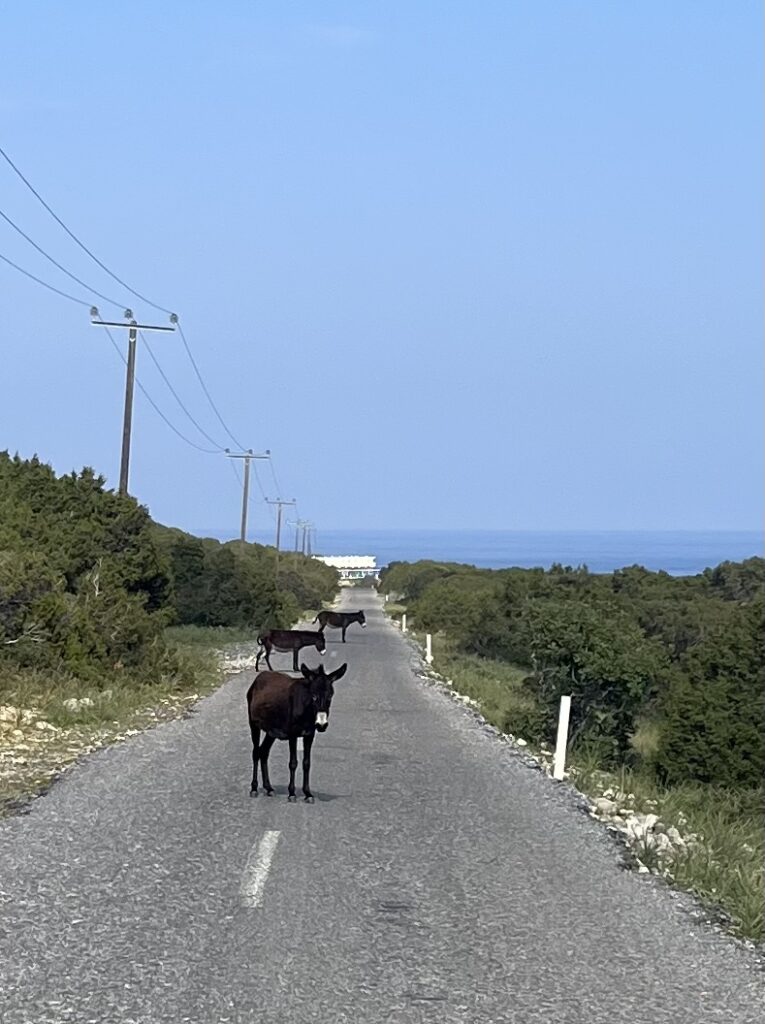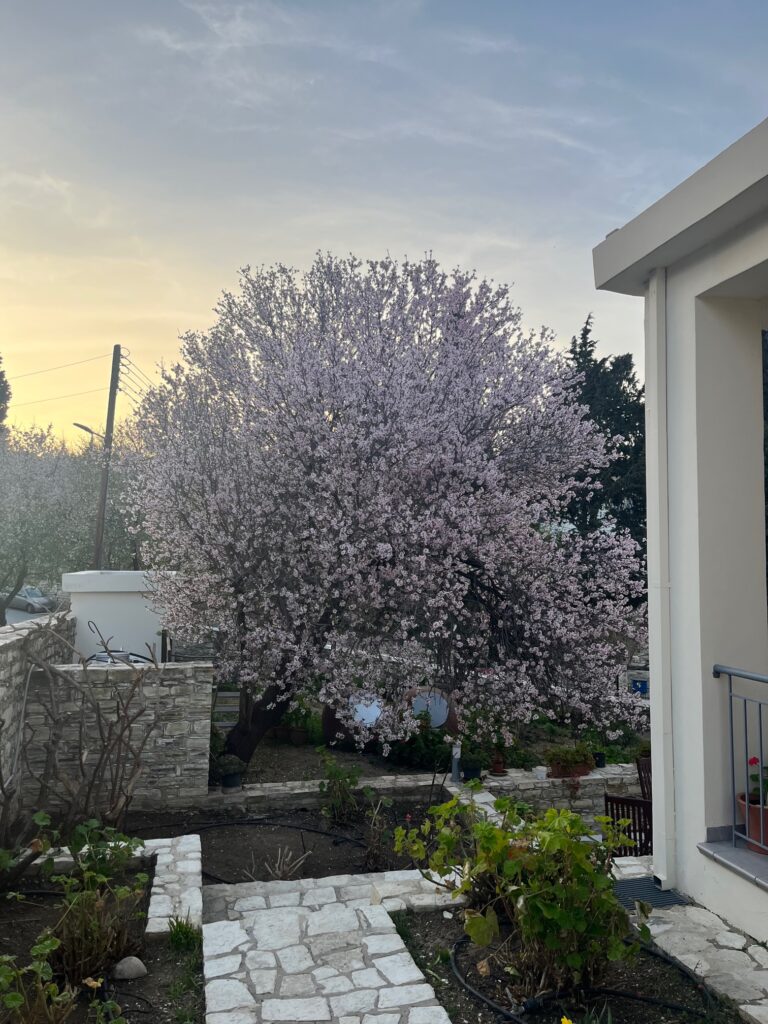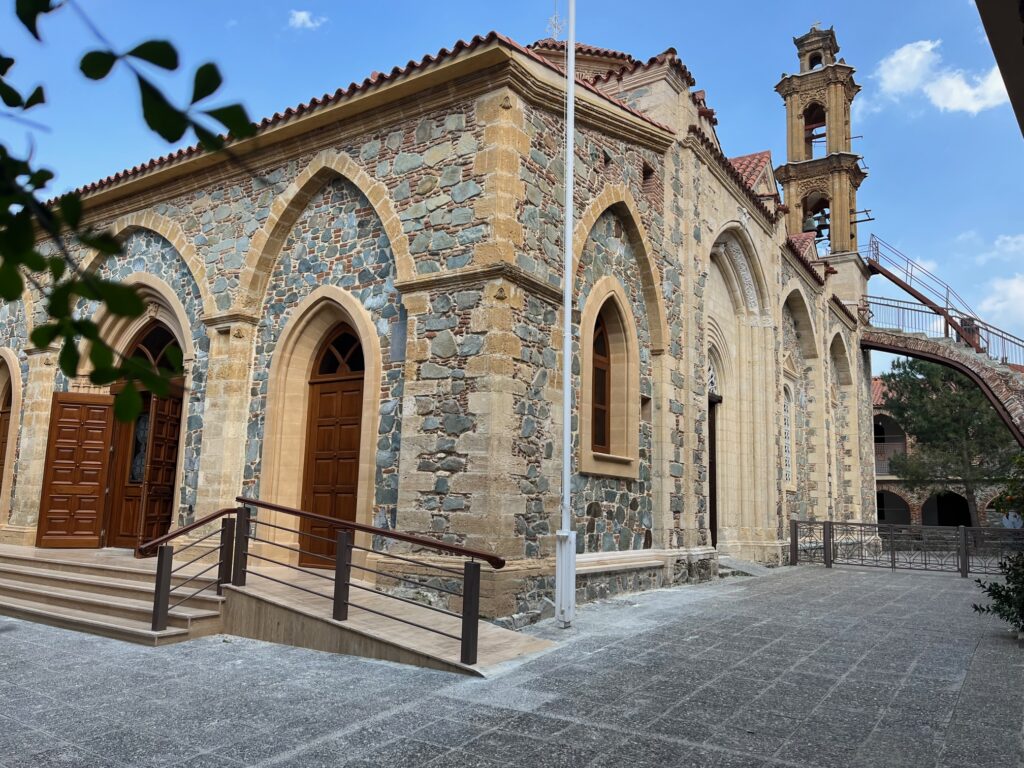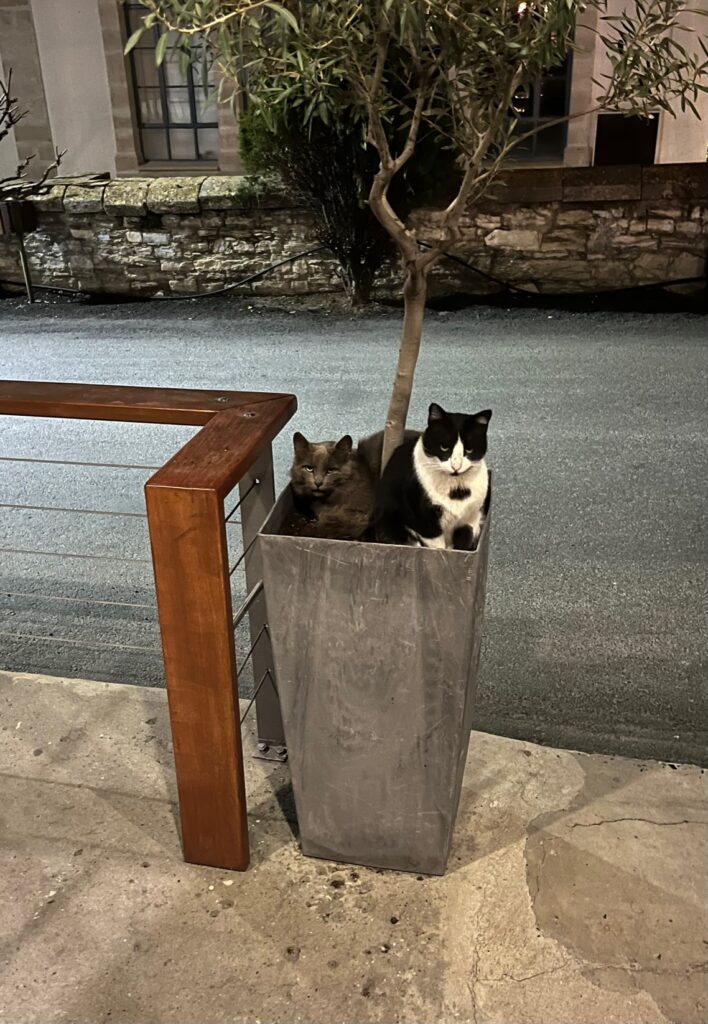When you’ve been to the Philippines three times, the only thing left to do is to go a fourth time so that’s what I did (with Pam). The event that drew us here was Pam’s mother’s (Andrea) 70th birthday. A party was being planned on the actual day in January. After 11 days in the Philippines, the plan was to head to Kyoto, Japan for four days. At that point, Pam would return to the US and I would head down to Kyushu in southern Japan for 11 days.
Since I’ve been to the Philippines three times and written about it each time, I will keep this part of the journal brief. If you want more background on this vibrant country, you can check out my journals from 2016, 2017, and 2023.
This trip would be entirely staged from Andrea’s home in Los Baños which is just over an hour from Manila. The residence sits above a classroom that is part of Andrea’s thriving Montessori school. Per usual, when I descend the stairs, I am often greeted by the most adorable toddlers. That said, the cute award goes to the four-year old boy walking around with a shirt that said, “One of us is right and you’re the other one.”
The other meaningful greetings came from two energetic dogs Zuma and Gollum. Zuma would get so excited to see me that I could always count on him to release some pee every time I approached. I reminded Pam that she never showed me such affection when greeting me.
Taking care of the dogs and chickens and so much more on the property was the ever-present and ever-smiling Ding. Complete with a decent but not perfect command of English (much better than my Tagalog), he did make me laugh inside when he brought out the dog’s food one evening and mistakenly said, “Time to eat the dog!” Were I a crappy, predictable 1980’s comic, I would have inserted a very one-dimensional joke that was decidedly poor of taste.
The party was a smashing success. About 100 people showed up. Very last minute, I was asked to say something “nice” about Andrea. Waiting to speak, I noticed a small sign hanging on the wall that said “The greatest thing a child can have is a great teacher”. I brought the sign with me to the front of the room and read it to everyone. I then added, “If we take this one step further, we can say that the greatest thing a teacher can have is Andrea.”
Major points scored but not as many as when I returned to “stage” 15 minutes later to perform a karaoke version of “Crazy Little Thing Called Love” by Queen. Incredibly, Andrea was sat in a chair facing me about four feet away. It was all too much.
For whatever the reason, the gods decided that the only other white person at the party should be a dramatic 78-year old first generation Sicilian-American named Sal. Taking in only 35% of what he said, I felt Sal was in character for my enjoyment. His accent was thicker than a bowl of wet concrete chowder. He easily could have added authentic flourish to any mafia movie. Sal has lived in Brooklyn for many years. He’s a retired electrician that enjoys non-country music forms of line dancing.
It was his lucky day since Andrea requested for as many of the guests as possible to learn the recently viral “Jerusalema” line dance. Since some of the party guests were learning on the spot, the song played over and over on a large speaker so people could practice. At about the sixth time hearing the song, Sal started to get irritated.
“We gotta stop this thing-a! It’s a-making me a-crazy! Chris, Andrea’s your a-mother in law; can’t you ask her to turn it off-a?!”
At that point, I feigned the need to go to the bathroom and exited. On my way up to the bathroom, I saw Sal pleading with one of Andrea’s staff to stop playing the song. Later, I discovered Sal was also trying to get his own personal music mix playing so he could teach people his various line dancing techniques. Sal was officially unleashed.
This trip was much tamer than previous ones but still fun. I spent the days walking around Los Baños, trying to familiarize myself with as many of the streets, restaurants, and shops as I could. Any time I left the gated property, I passed by the squatters that resided along the western wall of Andrea’s lot. Actually, these squatters are on her property but she inherited them when she purchased the land over 30 years ago. Instead of rocking the boat, Andrea and her husband Orly wisely decided to let them stay. They don’t take up an enormous amount of space and they do offer a bit of protection.
The funny thing is that some of these squatters have more money than you might think. One of them has a car and a few others have legitimate properties elsewhere but they maintain some sort of presence in the small structures so as not to lose their squatted location. In fact, when you go around the Philippines, you start to realize there are a ton of squatters in this country. When you ascend the road to Mount Makiling in Los Baños, you will see people park their scooter on the side of the small road and then vanish into the forest as they make their way to their technically illegal homes.
The other thing I did was essentially become Norm of Cheers at my favorite bar restaurant, Meisters Uncorked. I went there so many times that on our last night, the gracious owner, David, treated us to an amazing meal paired with four incredible Japanese whiskeys.

Our next stop was Kyoto. I was here eight years ago and Pam was last here 22 years ago when she worked at Osaka University from roughly 1999-2002. Our plan called for four nights at the luxurious Cross Hotel.
The next day we walked many miles through the city, first heading south through Pontocho alley and over to Gion or Kyoto’s most famous geisha district. As we neared Gion, we began to see many Japanese people in rented traditional clothing walking in the streets. I remember this from eight years ago. What I did not see eight years ago were the handful of white folks here and there that were also dressed in the same attire. This was lame and diluted this charming background effect. Upon seeing a young western male with a mustache in a traditional kimono, a couple older Japanese ladies started laughing furiously. This got me to thinking that maybe the Japanese encourage westerners to dress up this way as to provide local residents with immeasurable entertainment. Maybe we should do the same? Maybe a Japanese man visiting Boston dressed up like a wealthy colonial with a powdered wig and an accidentally backwards tricorne hat that sauntered awkwardly over cobblestones in the Faneuil Hall area in his shiny black shoes with equally shiny buckles would allow tourists to add a value to the local landscape beyond the money they spend.
I felt like a cell in a crowded blood vessel as we walked up to Kiyomizudera Temple. I was amazed at how crowded the city was for late January. The weather was not awful this time of year but it was chilly and a light snowfall hit the area a few days previously. The last time I was here it was in March and the crowds seemed thinner. Some Osaka residents later told us that Kyoto has seen an uptick in visitors over recent years which hasn’t made all the locals happy. Many complain about the presence of more litter whose blame falls mainly on Chinese tourists for some reason. Perhaps these particular tourists make quite a spectacle when they litter by simultaneously screaming in Mandarin and waving their passport while littering? Maybe someone from Japan can easily detect a littering Chinese citizen without these obvious markers? Or maybe the Chinese provide the perfect fall guy?
Pam and I then walked west over to the shopping street of Shijo dori. We entered a pharmacy so Pam could purchase her beloved Shiseido products at prices only fantasized about in the states. We also looked for a nail clipper since Pam often tells stories of the amazing Japanese nail clipper she once owned. Judging from the packaging of one, this nail clipper seemed to be likened to a Samurai’s weapon. The marketing was effective and we bought two. On her way out of the country, Pam also bought an umbrella since she claimed the best umbrella she ever owned was from Japan. After paying too much money for it and returning home, she realized it was made in Germany. On our way back to the hotel, we squished our way through the packed Nishiki Market.

That night, we got into a cab and drove to my favorite Kyoto restaurant: Okariba. This place is always filled with locals and smoke, the latter being sourced from the inadequately vented barbecuing that takes place in the center of the dining area. This rustic every-man establishment oozes with protein. The text found in the “Maps and Directions” page on their website says it all: “Okariba is the set of sliding wooden doors on the left, just look for the unmistakable signs featuring the shotgun wielding cannibalistic boar mascots.”
I showed the 77-year old owner, Aoki, a picture of the two of us from eight years ago. I told him my experience was so legendary that I had to return with my wife this time. He appeared to be authentically touched by all of this and proceeded to roll out the red carpet. He asked the same question he asked me the last time I was in there: “Are you hungry?” Knowing the perils of an affirmative response, we did so regardless and proceeded to sample just about everything on his menu. We were served wild boar, small deep fried trout, grilled rice, grilled trout, grated radish, horse sashimi, duck loin, deep fried grasshoppers, bee larva, three different types of sake including a dessert plum sake, and a pack of hand warmers.
He also gave us some plum sake to go in an empty Perrier bottle. In fact, he was about to create our to-go bottle but got distracted by a telephone call. While on the call, he motioned for me to pour some plum sake from the distillation container to a smaller container that I could easily pour into the Perrier bottle. I did so but clearly did not fill it up high enough since he started to point to the very top of the Perrier bottle, indicating he wanted me to take as much as possible. I tried again and although he was still on the phone call, he watched me closely and when he saw I still came up about a half inch short from the top, he shook his head and gave up. Completely stuffed and smiling, we decided to walk the mile and a half back to the hotel instead of taking a cab.




The next day we boarded the Eizan electric train to Kibuneguchi and walked about five miles along a road into a little quaint village, then through forest and over a small mountain that ended in the village of Kurama where we ate at a vegetarian Buddhist restaurant that cleansed our souls and digestive tracts. It was here I was reminded how off-putting the Japanese can find it when you try to tip them. When I tried to tip the gentleman at the cash register, he looked like he entered whatever phase one would enter just before becoming insulted. In most other countries where tipping is not common practice, a person will accept a tip either because they are happy to receive more money or because they understand tourists may behave differently and are therefore patient of the tipping phenomenon. In Japan, a tip seems to bring their honor into question. In their minds, the honorable thing is to say you will charge someone X amount of dollars for something and then stick to that amount as agreed.

That evening, we ate at a nice obanzai restaurant near the hotel that featured a meaningful representation of Kyoto-inspired fare. The room we ate in was a traditional setting with bamboo tatami mats on the floor and low tables that required one to sit cross legged, something my overworked hips and knees refuse to do. Not caring how out of place I looked, I simply leaned against the wall and stretched my legs out along side of the table. I don’t think I received any dirty looks.
With most of the restaurants we went to, everything could be done on your phone after scanning a QR code. You could order your drinks and food, summon your waiter, and request the check. Although a tad impersonal, the system was extremely efficient. I was amazed at how fast staff would respond to any request I made over my phone during dinner.
Don’t jaywalk in Japan. I mean, I jaywalk here but I try to only do so in minor intersections or when no one is looking.
In the morning, I left the hotel and walked over to a bakery/restaurant to buy a coffee. While standing in a small line out front, a young Japanese man and middle-aged woman used unofficial sign language to ask me what the line was for. I used my translate app on my phone to tell them this line was to wait for a table. They nodded politely. I then used my app to say that I was simply trying to get a coffee to go. They again nodded politely. For good measure, I used my app a final time to say that now I can speak Japanese. They laughed heartily.
Pam and I then took the subway southeast out of the city about five miles to visit the Shingon Bhuddist temple Daigo-ji. Here we hiked up the mountain behind the main grounds to visit the upper temple grounds. On our way up, we passed an older gentleman descending his way back from the challenging climb. He looked extremely unsteady and slowly stumbled over the loose rocks in his path. About every 20 feet, he would fall on his butt. Since he was shorter, his knees were bent, and his pace slow, his falls were gentle. When he was thirty feet beyond us, I yelled “Konnichiwa!” to get his attention. This caused him to fall again which I felt bad about. I rushed down to him, helped him to his feet for which he weakly replied “Arrigato.” At the start of our hike at the base of the trail, I had grabbed a couple bamboo walking sticks which I now offered to him but with classic polite stubbornness, he refused three times.
Near the top, mother nature called upon me with such volume and urgency that I had to retrace my steps quickly to a rough bathroom that we had passed five minutes previously. Time was not on my side and adding to the anxiety was a desperate search for toilet paper. There were four stalls and it was not until the last stall that I found my beloved shit tickets. Once this matter of intense priority was executed, I re-created exactly what happened upon entry to the bathroom. Enjoy.
We enjoyed the peaceful temple summit with no one else around and then descended back down the mountain and to the subway station. We then had a lovely dinner at a great shabu shabu restaurant in Kyoto with two of Pam’s former Filipino workmates that she knew from her days at Osaka University over 20 years ago. Nirianne and Noel proved to be about as lovely and kind as people could be. We reached out to them very last minute but they made such a wonderful effort to meet with us in Kyoto. Nirianne had a thoughtful care package for Pam filled with Japanese sweets.
The entire dining experience was fantastic but along with the breakfast we had the following morning, Pam and I were reminded how the Japanese can be such sticklers for rules. At the shabu shabu restaurant, we were told it was all you could eat but we had to be done in exactly 90 minutes. The pleasant waiter came back to remind us of our exact completion time. Just to make them sweat a little bit, Pam went back again to the ice cream counter two minutes before the completion time.
At the breakfast diner the next morning, we were presented with a menu that started with a bunch of set meals. There were a few side items but every item appeared to only come in a set. When we tried to order things separately, it caused quite a stir. You couldn’t simply order some scrambled eggs or sausage only; scrambled eggs only came with a meat item, a salad, toast, and certain drinks. There was a bakery attached with incredible baked items. You were allowed to pay for them separately and then bring them back to your table or get them to go. Wanting to eat some at our table immediately and some later, we just asked for everything to go but when the waitress got wind of it, she said the price was different if you ate the bakery items at the table so we simply received our to-go items in a sealed bag and did not dare to enjoy them until later. We were exhausted by the end of our breakfast. The Japanese are clearly fans of efficiency so my guess is that all of these restaurant rules are born out of the desire to not waste time and resources but 30 minutes in this place made us feel like we just disarmed a timed explosive with four seconds left to detonation.
We then caught a cab to Kyoto train station where Pam boarded a train to Kansai airport and I boarded the Shinkansen bullet train to Nagasaki. An announcement over the station intercom politely told us that Pam’s train would be delayed 16 minutes due to a “passenger contact incident”. This was the futuristic and sterile way to say “someone got hit by a train”.
After amazing Shinkansen rides, I arrived in Nagasaki. For a $180 a night, I was able to get a room at a five-star Hilton. In fact, the dollar seems relatively strong here in Japan. Food and drink also work out to be a good deal cheaper than back home in the Boston area and the food quality here is pristine. For about $18, I could have a good meal with two very fresh draft beers. Ironically, the most expensive food items appear to be things that originate from Japan. At the shabu shabu restaurant, beef coming from the US was significantly cheaper than beef from Japan. Perhaps the Japanese beef is of a superior quality but regardless, the US beef had to practically fly halfway around the world to get here and I’m sure it flew business class since American beef is so classy.
Once settled in at the hotel, I went down to the sixth floor to use the sauna and hot bath. Let me tell you, nothing pleases me more than to jump into a hot bath with a bunch of naked fellas I don’t know. But if the book Shogun has it right, the Japanese are unaffected by nudity and therefore hopefully won’t regard me as some evil hairy Kami.
The next morning I initiated a long walk through the city. The first point of interest was the Twenty-Six Martyrs Museum and Monument honoring the 26 Christian martyrs that were killed in the city in 1597 on orders from Japan’s ruler Toyotomi Hideyoshi. Pretending to be one of those annoying tourists that does everything possible to absorb all historical and cultural minutia of the place they’re visiting, I went to the Nagasaki Museum of History and Culture. From there, I stopped in at the Kofukuji temple and then over to the interesting, large scale recreation of the European trading post of Dejima. In the 1600s, Japan started to isolate itself and stop the spread of Christianity so Dejima was constructed as a way to contain European traders. Until the end of the Edo period in the late 1800s it was the only trading port between Japan and Europe.


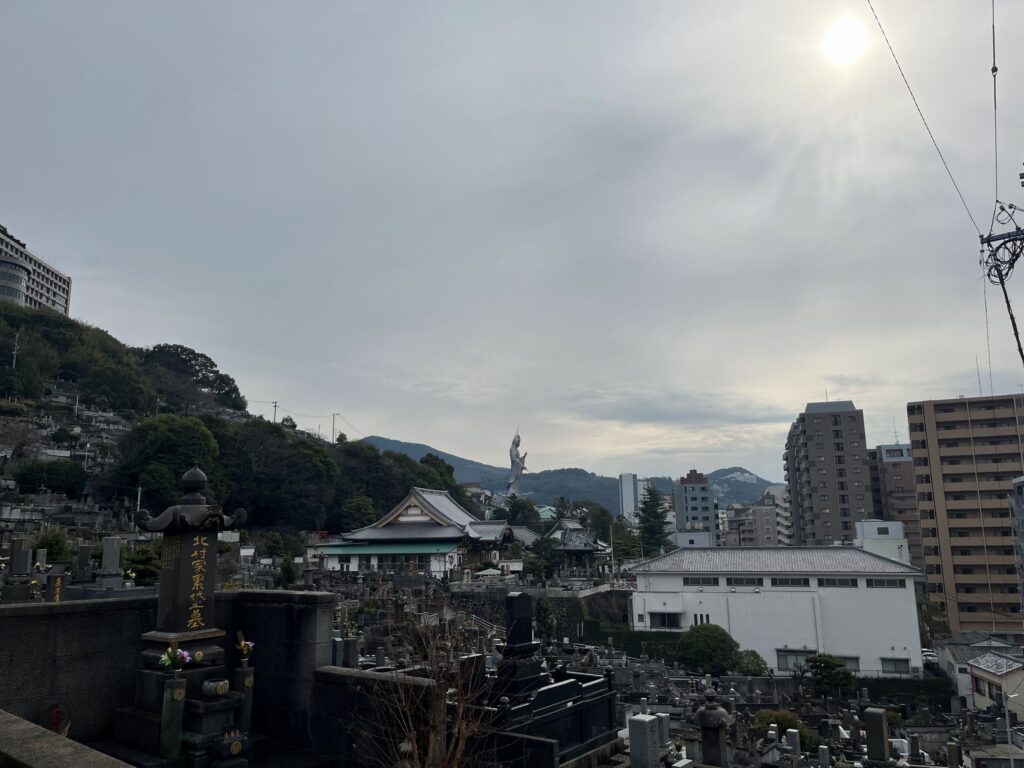



I really do enjoy Nagasaki. One thing that pleases me about it is that it is less geared for English speaking bums like myself when compared to Kyoto. The menus in the restaurants that I have visited here have offered little to no English which has made the food selection process fascinating. I will confess that I have a translate app on my phone that can scan and translate text that is foreign to me but even with that, (since the app often struggles to accurately translate from Japanese to English) I find myself diving into the great unknown every time I go into most of these restaurants since it is quite often void of any pictures. It seems I always end up ordering way too much food. The first night I accidentally ordered lots of sushi and about a gallon of hearty eggplant/pork stew. My gut was bursting in the end, unaided by the three beers I added to this maxed out digestive bid.
The following day, I paid an extremely somber visit to the Nagasaki Atomic Bomb Museum. In addition to a large amount of relics to view, the museum does a thorough job of allowing one to imagine the experience moments before, during, and long after the event. Practically all of the attendees appeared to be Japanese. It amazed me how stoic they all were. After seeing how glass melted into unrecognizable blobs, how concrete was fried and pitted mercilessly, how thick steel was twisted like soft taffy, how vegetation of any kind was vaporized…then looking at a wide angle model that gives a recap of the fate of anything anywhere near the hypocenter (the spot on the ground directly below the explosion) – the absence of anything recognizable…then trying to consider what it would have been like to be any living creature among all that, it’s impossible to process it or at least imagine it.
It’s hard to control or define your emotions when you think of Japan in the first half of the 20th century (perhaps it’s more accurate to speak of those who were in charge in Japan at this time). You become furious when you consider the Rape of Nanjing where 200,000 Chinese died by the hands of the Japanese military and tens of thousands of women were raped or Japan’s incredible reprisal for the relatively minor damage received in America’s “Doolittle Raid” where they killed 250,000 Chinese civilians or the breathtaking viciousness of their POW camps or the Bataan Death March or the hundreds of thousands of women the Japanese military forced into sexual enslavement. But then you think of the innocent Japanese civilians killed in Hiroshima and Nagasaki and it softens you immensely and confirms the sad truth that the great loser of war is the common many who are simply trying desperately to mind their own business.
One of the most miraculous stories that come from the atomic bombings is the one of Tsutomu Yamaguchi. An employee of Mitsubishi Heavy Industries, he was present in Hiroshima on August 6, 1945 during the first bomb dropping. Although wounded, he returned to his home in Nagasaki and then to work on August 9. While his incredulous supervisor was in the middle of criticizing him for saying that one bomb destroyed a city, the second bomb detonated in Nagasaki. He is one of 165 double A-bomb survivors. He died at the age of 93 of stomach cancer.
Confused and emotional, you exit the museum and look around at the incredible rebirth that has left behind a vibrant city. What a resilient people. There is a great scene in the book Shogun where there is a massive earthquake in a small village. Within an hour or two after the earthquake, villagers have already begun the process of rebuilding. I laughed when I read that part in the book but after visiting the museum and then walking around Nagasaki afterwards, it’s not hard to imagine the reality of such a scene.
This magnificent rebirth and urban vibrancy that Nagasaki emits is perhaps best believed on the top of Mt. Inayasa at night. To do this, I boarded a gondola that took me to the top. The night view here is touted as the best in Japan and one of the best in the world. Looking out onto what appeared as an enormous pile of beautiful fireflies veiled thinly by fog, I again was amazed at this city. I’m not sure any other nation on earth is capable of this return.
And yes, I have been reading the book Shogun on this trip.



The next day I took a few trains to Kumamoto, rented a car, and drove out onto the islands of Amakusa. I settled into my hotel fantastically named SantaComing Hotel. Throughout the hotel, there were pictures of large groups of people dressed as Santa Claus in different settings. One even included a bunch of Santas out on a boat. This country can be so delightfully weird.
On the recommendation of the receptionist at my hotel, I walked up to a wonderful little izakaya restaurant in town. Right away I noticed that the Japanese in smaller towns are a little bit friendlier and more willing to talk but I think this is true everywhere in the world. The owner struck up a nice conversation and whenever her brief supply of English ran out, I employed the awkward use of my translator app.
I ordered a couple dishes and it went so well that I got cocky and ordered a third. I thought I was ordering some sort of tempura vegetable side dish but instead, a very large and scary fish head landed before me. I did my best to pick at some of it but it was pretty horrifying. I just didn’t have the grit to eat the brains and eyeballs.
It was at this restaurant that another funny element of Japanese restaurant culture struck me. It seems that many restaurants here have no issue with creating a very small music mix and putting it on repeat. The mix may contain seven songs or in the case of this particular restaurant, they were literally playing the same song over and over.
The following morning I drove around a good chunk of the island, stopping in at the remains of Tomioka Castle, Shiratsuruhama Beach, the Oe Tenshudo Catholic Church, and finally the neat little fishing village of Sakitsu. This village also has an interesting history with Christianity so I checked out the church there and hung out with a bunch of stray cats. It was not until this trip to Japan that I realized there were so many Catholics in this or any part of Japan. It was odd to come across a Catholic church and then remove your shoes as you enter.

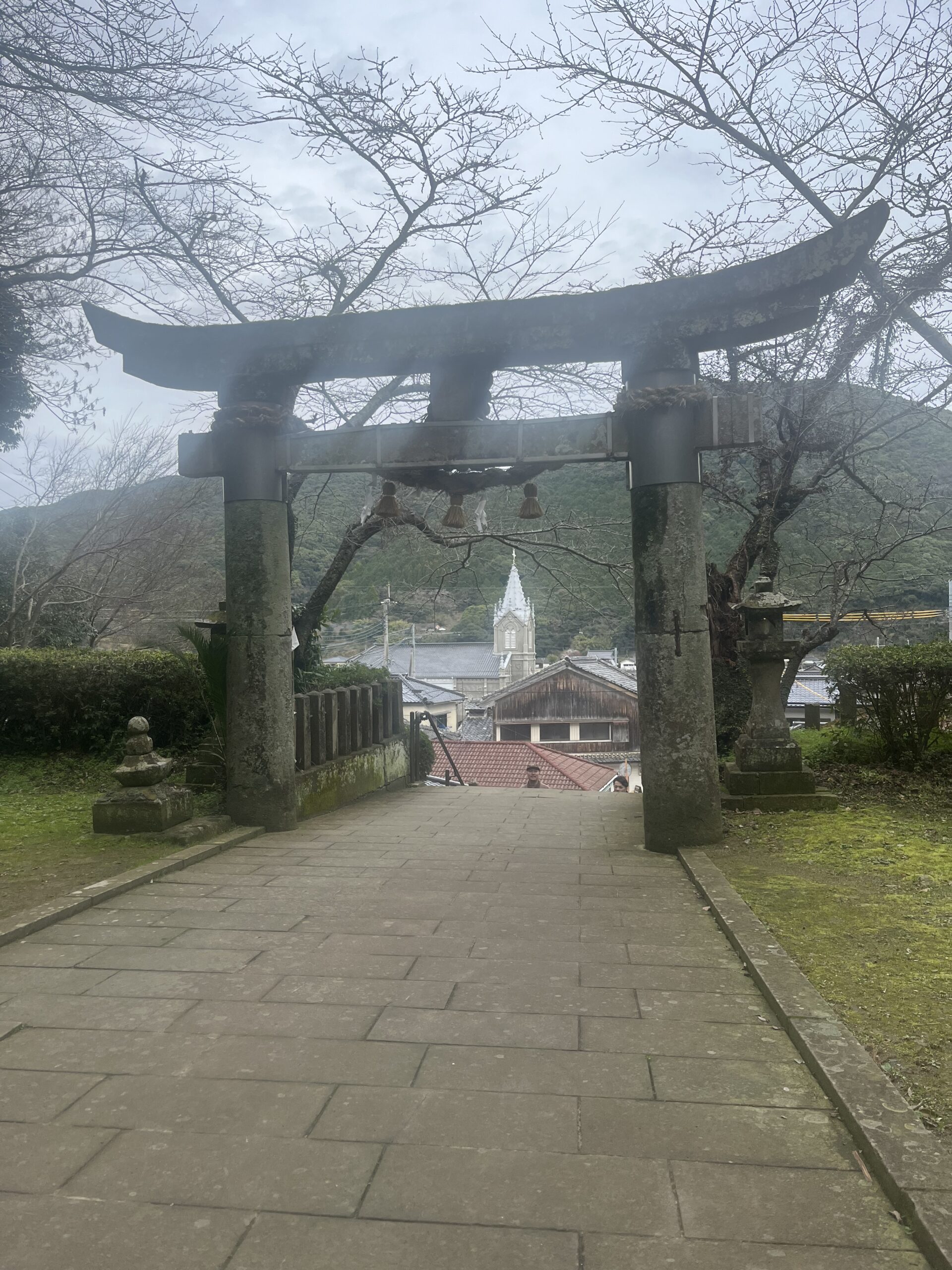
That night, I went to a nearby seafood restaurant. I can easily say this place boasted the freshest seafood I have ever had. How do I know? Well, some of my seafood was actually still moving in my beloved set meal. In the upper left corner, a fresh pile of sushi awaited me. In this pile was a raw shrimp which I don’t believe I’ve encountered as sushi before but this being Japan, a place I trust with my life when it comes to food (other than fish heads) to the point if they put a plate of seaweed topped with peanut butter and frog shoulders, I’d probably eat it. After I ate the body of the shrimp, only then did the head start to protest and dance around my plate. Dinner and a show.
Sadly I had to leave Santa‘s home away from home. I drove south to the port town of Ushibuka where I purchased the ticket for a ferry that would take me over to Nagashima Island and then on to Kagoshima. I had about 30 minutes to spare so I walked through the quiet and virtually empty town streets looking for a halfway decent café. I found one and ordered a coffee. As I was trying my darnedest to enjoy the coffee and read my book, I started to hear loud sirens outside. I finished up and paid the owner. As I walked outside, the locals were all running in the same direction about 60 feet down the road. Since it was on my way back to the ferry, I followed them. When I reached the end of the road, a building I had just walked by about 15 minutes previously was now on fire with firefighters trying to hose it down.
As I looked at this fire, I hoped for two things: 1) no one was hurt and 2) I didn’t get blamed for the fire (I was arguably the last person to walk by the building right before the fire started). The amount of smoke rising from this building was immense and firetrucks were coming from all directions. The building looked commercial and as it was a quiet Saturday afternoon, it didn’t look like there was much human activity there. People continued to collect at the scene. I went left back towards the ferry and discreetly walked against the flow of incoming onlookers and without breaking stride, I hopped in my car, started it up and instantly joined the final procession of cars onto the ferry. Hardly any time passed before the large boat started to move away from the dock giving my departure from Ushibuka and its newly minted multiple alarm fire the fluidity and efficiency only seen in cinema. Once on the top deck and staring at the massive column of smoke that slowly moved further away, I couldn’t help but feel like Samuel Jackson in Unbreakable.


After disembarking from the ferry and seeing no authorities waiting for me, I drove south into Kagoshima and checked into a 19-story Sheraton hotel that was practically brand new. Again, thanks to the strength of the mighty dollar, I was staying in this place for about $175 a night. Once all of my clothing was sadistically organized in my room, I walked north into the central part of the city and ate at a great little restaurant called Kurobuta. The specialty of this eatery was tonkatsu which is essentially deep fried pork cutlets. I had their “Kurokatsu” or black cutlet which was made with black breadcrumbs comprised of bamboo charcoal, black sesame, and cocoa among other things. The dish looked like a scorched turd that had been driven over several times by a car but it tasted like an imperial victory.
To celebrate this victory, when I arrived back at the hotel, I took the elevator up to the top floor and sipped on a fine Japanese whiskey by the name of Taketsuru by Nikka. The bar seemed to be full of what I assumed were successful Japanese businessmen who were drinking and laughing loudly. Perhaps this is the one example of when the Japanese are loud. Respectfully by their sides were their special ladies. From what I have read, there is quite a hefty gender gap, favoring males, in the arena of corporate management. Considering this trend and using my own senses in the bar, the vibe I absorbed was one I used to feel at my father’s corporate vacations in the 80’s.
But the view was nice!
The next day I hopped in my little Toyota Yaris and drove over to the port area where I boarded a ferry that took me over to Japan’s most active volcano, Sakurajima. It used to be an island but in 1914, it had such a massive three-billion ton eruption that filled in a 400-meter wide by 70-meter deep area in the ocean that connected it to the mainland.
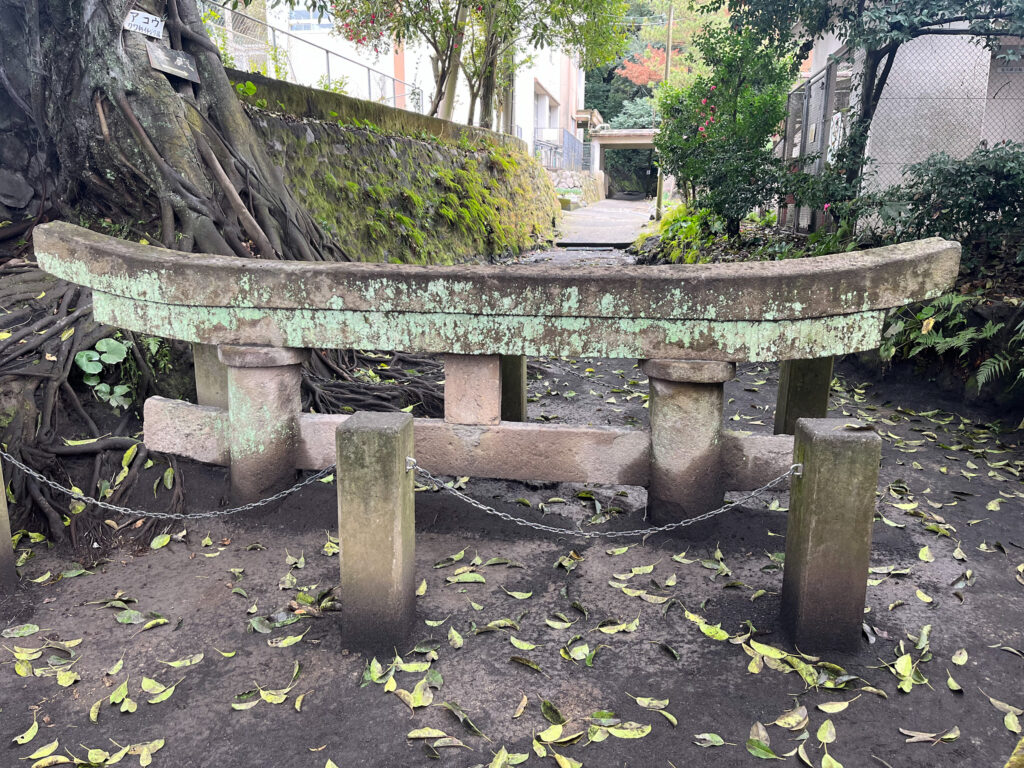
That night I returned to Kurobuta for the same meal. The staff smiled in acknowledgment of my return. The neighborhood this restaurant is located in is the most happening neighborhood in Kagoshima. In addition to lots of shops, bars, and nice restaurants, there are also quite a few naughty gentlemen clubs. I’m not exactly sure what goes on inside but pictures of attractive and slightly playful young ladies appear to be promising some high degree of attention. There are also well-dressed men out in the street trying to bring people in but not one of them approached me. I took this as a compliment since I clearly don’t smack of a white man with an unrelenting Asian fetish. Being married to an Asian, I’ve learned to develop quite a poker face when confronted with attractive Asian ladies.
Back at base, I returned to the scene of the crime on the 19th floor for some more of that well-built whiskey.
Today I had to return my trusty little Yaris. Before I did, I checked out the renown Seng en Gardens which were built in the 1600’s by the family that ruled Kagoshima for about 700 years. As I toured these elegant gardens, I walked by a white woman that I had seen the day before at the Sakurajima observatory. At least this time of year, there doesn’t seem to be a lot of white people in this area so they kind of stand out. The day before I made eye contact with her and said a quiet hello but she was a bit mousy and didn’t really respond. This time, we made eye contact again as we walked within inches of each other on a narrow walkway. I said hello again. For old times sake, she again did not say hello and if you looked at her face, you would’ve thought that I farted into her mother‘s favorite pillow.


At night, I found this wonderful little place to eat simply called Kitchen and Bar. I knew I was in for a positive experience when I saw that the handle on the front door was a small ukulele. More ukuleles decorated the left wall as I entered. There was only one other patron in this small establishment. Behind the bar was a genuinely kind woman with glasses in her late 50’s. Her husband was in his mid 60’s and did the cooking. A red towel covered his head. The restaurant had a bit of an American feel, helped by the fact there was American soul music playing.
“Donny Hathaway?” I asked.
The husband nodded affirmatively.
I opened my translator app and wrote that Donny Hathaway sadly committed suicide in New York in the 70’s.
“Hai, hai…” he confirmed and then did his best to mime someone jumping out of a window. It was the 15th floor of his hotel, the one he was staying in while recording an album with Roberta Flack. He was only 33 years old. His voice reminds me of Stevie Wonder sometimes but more beautiful.
They served me perfectly prepared and fried Thai fish with rice, salad, pickled vegetables and miso soup. The two beers I ordered went down easy and like all draft beers I’ve had in Japan, were impeccably fresh. About halfway through my second, they poured themselves beers and we all clinked our glasses. I wish I had found this place the first night I arrived.

I visited the 19th floor again and opted for Suntory’s Chita whiskey followed up by a Taketsuru. Abiding Bill Murray’s lead in Lost In Translation, I feel compelled to drink Suntory while in Japan. In fact, I’ve been traveling with a small 180ml bottle of their base model in my suitcase as a backup in case I can’t find something better after dinner.
The next day I settled up with the mighty Sheraton and caught one last ride on the streetcar, heading towards the port for the high speed jetfoil ferry that would take me to the island of Yakushima for three days. I had over an hour to kill so I planted myself right on the water and lit up a cigar. Keeping me company was Sakurajima who was also smoking. A woman at the hotel told me that it is not uncommon for the volcano to throw out ash that then rains down on the city if the winds are right, causing the inhabitants to walk around with face masks on and holding umbrellas overhead for protection.

Upon arriving at Yakushima, I met the owner of the ladies-only car rental company. She was very kind and thorough as she took me through all the vital features of my quirky Suzuki Hustler. From there I drove south and around the island. I stopped in at an interesting little gift shop that was run by a very interesting character named Katayan. He was probably in his mid to late 50s with long gray hair. Aside from making incredible little crafts and jewelry from local cedar, seashells, and whatever else he could get his hands on, he also passed the time surfing and playing bass guitar in a great funk band. I know the funk band is great because he let me listen to some of his music. I was starting to notice that the people here on this island are almost a different breed from the mainland. They are certainly more relaxed. They come across as Japanese trying to get away from Japanese. I was so impressed with his creations in his tiny little shop that I purchased several small items for key individuals back home.
When I made it to the inn, Shikiyonado, I was greeted by the most wonderful couple of about 50 years old. The wife Satoko couldn’t help herself but smile and laugh as it was clearly her natural disposition. As she finished introducing me to the property, her husband Kentaro ran up the driveway bathed in sweat, having just finished a long run. The long fit of exercise did not diminish his energy or smile.
The following morning he recommended that I hike through the Shiratani area in the north part of the island to witness the amazing ancient cedar trees. I did as he advised and was a better man for it. Back in the Edo Period (1603 – 1868), this island saw a lot of cutting of these ancient cedars so it’s not as dramatic as it once was. During that time frame, there was a large demand for cedar shingles as they were used on many houses on the mainland. Some of the old stone paths that were used for this logging are still in use today as you walk through the forest.
The entire forest would have worked well in Lord Of The Rings or any similar fantasy, sci-fi film. This is why it comes as no surprise that this forest provided much of the inspiration for the 1998 animated film, Princess Mononoke. My visit saw a lot of gray, cool, and light rain. Normally this would be unappealing but these conditions worked well with the abundance of moss and charged streams surging over waterfalls while old giant trees added to the darkness.




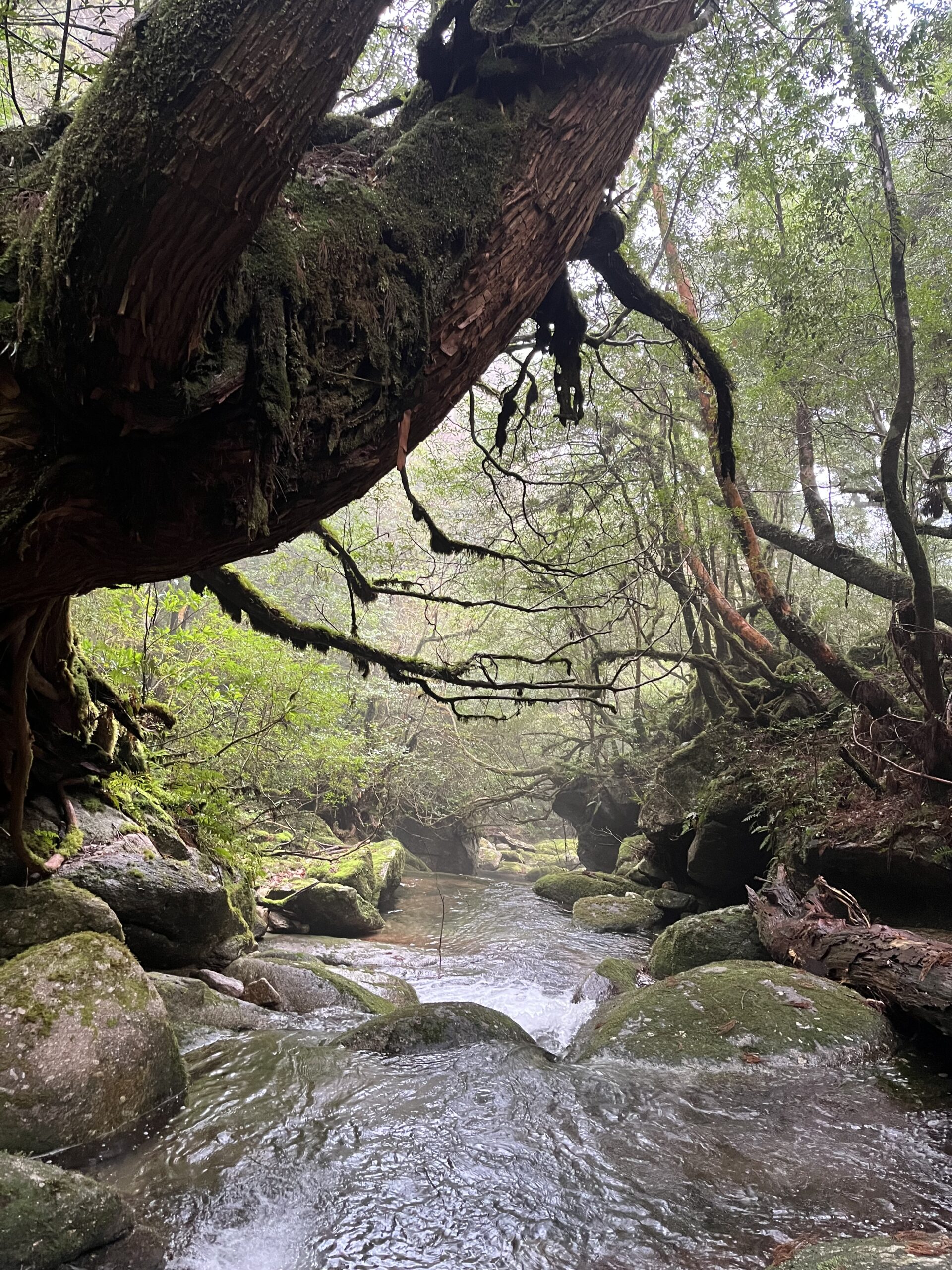

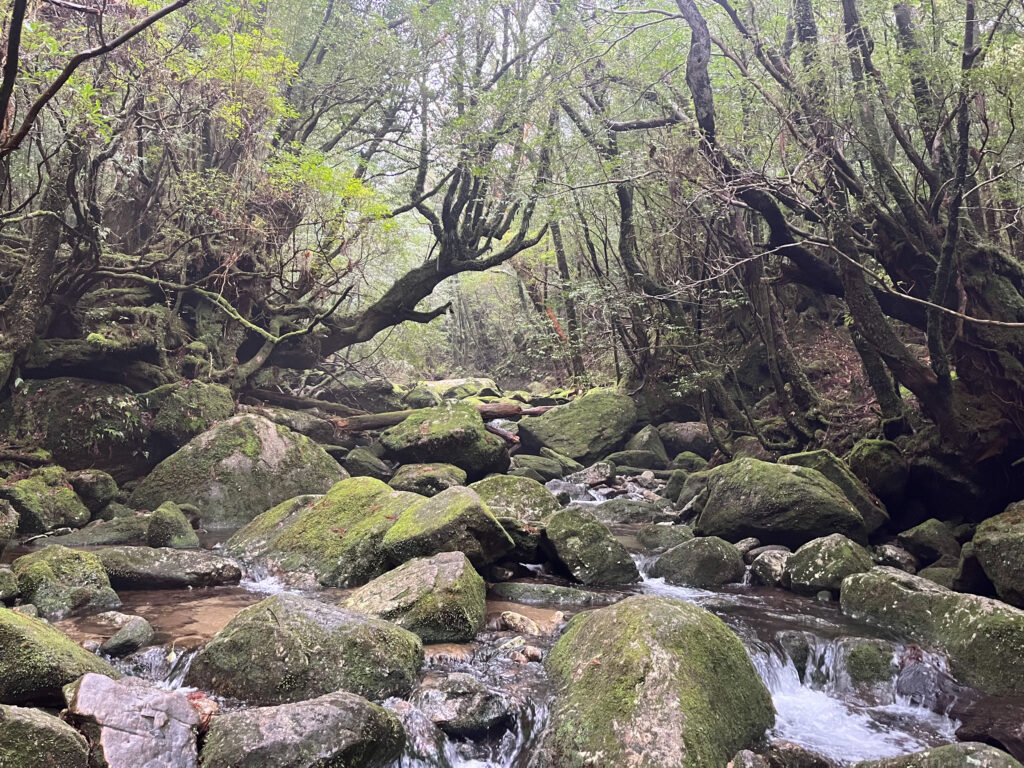
Back near my inn, I stopped in at the local onsen (hot spring). The water was a toasty 49 Celsius (120 Fahrenheit) and based on what the internet tells me, humans will burn after 10 minutes in waters of this temperature, especially where skin is thinner. I was delighted to discover this tidbit after I had spent seven minutes in this onsen. It probably explains why my genitals felt like they were beginning to boil around minute six.
The next morning, I told Kentaro of my plan to ascend the 950-meter peak of Motchomudake right behind the inn. He had prepared me for the fact that this hike was no joke. The five-kilometer round trip with a 700-meter elevation gain was not the most monstrous hike I have done but the ascent was intense with so many rocks and roots. At the end, when you thought you were so close to the top, the trail went back down steeply 125 meters and steeply back up 150 meters. Frequently there were ropes to help you up or down steep, slippery parts. To reach the very top, unless you were a rock climber, you had to climb up an almost vertical 20-foot high section of rock with the help of a knotted rope.
The hike was one of the best I have ever done. It took me just about six hours round trip and excluding the monkeys and one other surprise visitor, I had the entire mountain to myself. About two thirds the way up, I heard something substantial moving behind me. I thought it was a monkey coming after me so I stopped, turned around and waited. It was Kentaro. He is in such better shape than I am that despite his delayed start, he was able to catch me. I was honored with his appearance. He told me that he tries to ascend this peak once a year but it has been two years since his last visit. There is a small shrine on the top to pay homage to the local deity so he did so.
Kentaro also called Satoko while we were on the peak. She went outside and looked up and could barely see us as I waved my orange backpack around like a raving idiot.


On my way back from the hike, my tired body requested the restorative, possibly placebo effects of the onsen again. If I wasn’t careful, I was going to start getting used to bathing with old naked Japanese men.
The next day I said my goodbyes to Kentaro, Satoko, and staff member Kako from Hokkaido that had decided to move to Yakushima permanently six months previously.
I flew from Yakushima to Osaka where I would spend the night before flying back to Manila and then back up to Seoul and finally back to Boston. I called Korean Airlines and asked if I could ditch the Manila-Seoul part of my itinerary and make my own way to Seoul from Japan as it would save me many unnecessary hours of flying. They said they would have to charge me something like $1500 to simply remove one part of my flight itinerary. Peckers.
At Osaka’s Itami airport, Pam’s friends Nirianne and Noel met me for dinner. True again to their strikingly generous form, they had many edible gifts for me to possibly share with Pam. They saw me to my bus that took me into Osaka. From there I boarded a commuter train south and alighted near Kansai airport. I walked into my hotel and found no staff anywhere in the reception area. Handling the check in process were two robot dinosaurs. I’m not sure why, but that’s just the way it was. Japan is the only country in the world that is weirder than I am.



